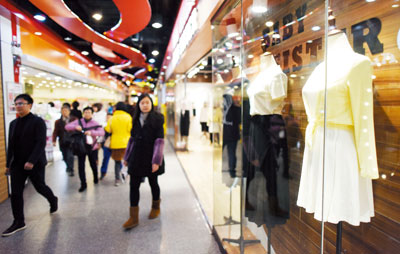|

WITH economic growth running at its slowest in a quarter of a century, China’s consumption patterns are changing, with wealthy middle-class households trading down from up-market to more affordable brands, and poorer families paring back on even basic purchases.
China’s top 50 retailers saw sales fall 6 percent at the start of the year, and sales of basic goods from noodles to detergent grew just 1.8 percent at the end of last year, down from over 9 percent just three years ago, according to Kantar Worldpanel data.
The weak sales of even cheap household goods underlines the challenge for China, desperate to get its 1.4 billion people to spend and give some fresh impetus to the economy.
“Maybe before, if I wanted something I’d just go and buy it. Now I only buy things I really need,” said Yang Shunjie, 28, a Shanghai-based client manager at a State-owned firm, who earns between 10,000-15,000 yuan (US$1,500-US$2,300) a month. He said he also shops more online where prices are cheaper and will wait for end-of-season discounts to buy new clothes.
This is a problem for sectors from retail to luxury and even fast-food, where many international names have banked on continued growth.
Procter & Gamble, whose China products include Pampers diapers and Tide laundry detergent, said in January its sales were “significantly down” compared with 2014. Infant formula maker Mead Johnson Nutrition Co. said price competition and a shift to smaller shops and online hit sales.
“We are seeing shifts within retail. High-end luxury goods have had a very good few years, but that’s coming to an end. Tastes are changing,” said Mark Williams, chief Asia economist at Capital Economics in London.
Westpac’s most recent consumer survey showed sentiment at its lowest since October. “The February update points to continued weak conditions and elevated job-loss fears again weighing on the consumer mood,” said Senior Economist Matthew Hassan, adding that any loss of momentum for consumer demand could raise the risk that growth stays weaker for longer.
Some firms are bucking the downturn.
International brands offering “affordable luxury” such as coffee chain Starbucks Corp. and high-end sporting goods giants Nike Inc. and Adidas AG have still grown. Adidas says it has not seen an impact on its business and plans to open some 3,000 new stores in China by end-2020.
But retail executives and consumer goods makers said China’s slow growth is punishing the sector and forcing many to cut back, focus on smaller, faster-growing cities and offer more discounts.
“We are struggling to adapt as sales move online or to small mom-and-pop stores,” said a senior sales executive at a major Western consumer goods firm.
He said inventory levels at some clients had jumped to as much as nine months, from a normal average of around two weeks.
For retailers and consumer goods brands alike, that means re-thinking their sales pitch. China-based advertising executives say some are adopting a two-tier marketing strategy: imported, premium ranges to target more affluent consumers, but also buying up popular and affordable local brands.
Reckitt Benckiser Group’s CEO said last month its Chinese sore throat remedy Manyanshuning was a “local hero.”(SD-Agencies)
|

